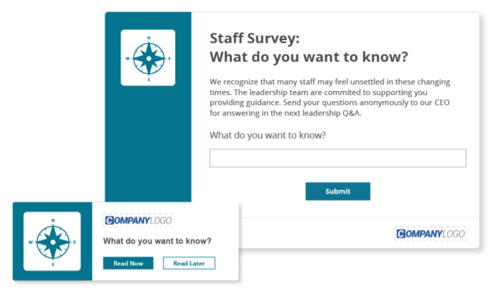
April is International Stress Awareness Month, which represents a perfect time for businesses to consider the issue of stress in their workplace.
Is your organization affected by stress-related problems? Are employee welfare and business performance being impacted as a result?
Recognizing and reducing workplace stress is an important consideration for employers – but where to begin? Here we’ll consider the scale of the issue, the value in addressing it, and some suggestions for changes you can make in your business.
How big is the problem?
A recent UK study found that 12.8 million business days were lost due to work-related stress, depression, or anxiety in 2018-19.
In the US, one survey found that a staggering 83% of workers feel stressed at their jobs.
Workplace stress is traditionally caused by factors such as too much work, too little pay, a poor work-life balance, lack of job security, or an oppressive working environment.
But new research shows that the COVID-19 crisis has displaced these traditional causes. Today’s biggest issues affecting employees' mental health are income, job losses and being exposed to the virus.
But despite this, many of the employees afflicted still appear for work every day despite being stressed out. It’s what’s known as “presenteeism” – being present for work when you’re physically or mentally not up to the job.
Getting on top of this issue is an important, though challenging, mission for businesses.
 (Source: American Psychological Association)
(Source: American Psychological Association)
What’s the value of managing workplace stress?
It may seem obvious, but businesses that attend to stress-related issues in their workplace can reap significant benefits in improved performance.
Helping employees manage stress at the workplace can result in a more robust organizational culture, increased productivity, better decision-making, improved service levels, reduced staff turnover, and fewer days lost to sickness.
Don’t just take our word for it though. Given it’s been reported that nearly half of all sick days taken by employees are due to stress, imagine how much extra work would be accomplished without the loss of these business days.
Fewer than half of workers believe their employers care about a work-life balance. Making some changes to reduce workplace stress could suddenly find your team skipping into the office each morning.

What are some tips for reducing workplace stress?
Stress is a significant issue for many people today, both in their work and home lives. Addressing it isn’t always easy, but there are some simple things you can do to reduce stress levels. Here are five suggestions that will work for your workplace.
1. Exercise
Getting those endorphins racing around the body is a fantastic natural way of reducing stress and improving physical health. Of course, it’s not always easy to make time for exercise when so much of our day is spent at work, commuting, doing housework, looking after the kids etc.
But even if many jobs at your organization involve sitting at a desk all day, that’s no reason to be stuck to a chair. Try promoting walking meetings instead of holding them in conference rooms. Get your meeting group together and have a stroll around the building. If you can get outdoors to do it in the fresh air, even better!
Employees will likely find that the change of scenery and active nature will even inspire new perspectives and fresh thinking.
2. Take a break
One of the fastest ways of reducing stress is to remove yourself from the stressful situation, however temporarily. Taking regular breaks from your desk or whatever you’re working on, and leaving your working environment, rests your brain and promotes a change in thinking.
It’s worthwhile encouraging your employees to regularly take a break. This is where tools like tickers are useful for sending reminders to staff to “stretch your legs, take a break, check your posture” etc. It’s simple but incredibly effective – suddenly you’ll find colleagues sitting up straight, breathing better, even doing some office aerobics!
As well as promoting good habits for taking breaks, this also demonstrates how the business genuinely cares for employee wellbeing.
3. Take control
A common cause of stress is not feeling in control of a situation. When an employee feels that they have no control over the circumstances or demands of their job, this can result in feelings of helplessness, which in turn increases stress.
Reasserting control over some part of a job, however small, is a helpful step in reducing stress. Give your employees flexibility to look for ways that they can tailor tasks or processes to their own preferred working style.
If they are still relatively new in a job, chances are they’ve inherited modes of working from their predecessor. They may not be able to change what they do, but employees will be appreciative of the ability to take control over the way they do it.
4. Workplace stress audit
Sometimes an employer simply won’t be aware of stress-related issues in their organization. Employees often internalize their concerns, and will only speak of them to colleagues they’re closest to.
Astute employers will look to take a workplace ‘temperature check’ to identify any issues with stress before they result in staff illness or impact business productivity.
Running an anonymous survey is an excellent way for employers to keep their finger on the pulse of their workplaces, without it feeling too obtrusive. For employees, it provides an opportunity to call out any concerns in a safe and non-threatening way.

5. Offer support
Compassion and empathy are essential in today’s stressful working environments. But many employers won’t have in-house expertise to effectively address staff concerns related to stress. It’s a complex and serious issue, which many managers will feel ill-equipped to handle.
Fortunately, dedicated agencies are available in every region which specialize in support and workplace counselling services. Search for a suitable agency online, or seek recommendations from your contacts in other organizations.
Engage with an agency you feel comfortable with, and avail yourself of their services whenever your employees have need of their support. Make sure all staff are aware of the service, and include it in your induction training for new team members.
Stress Awareness Month offers a timely opportunity for employers to assess how well they’re set up to recognize and address stress in their business. Taking steps to reduce stress will result in a happier workforce, fewer working days lost to illness, and improved overall performance.

Download: Employee Wellness Guide
Get the guide for six tactics to improve employee wellness and how to achieve these through your communications.


